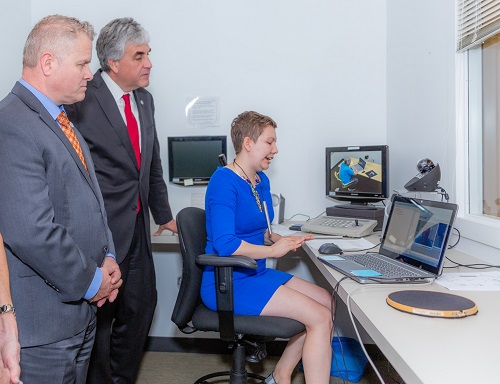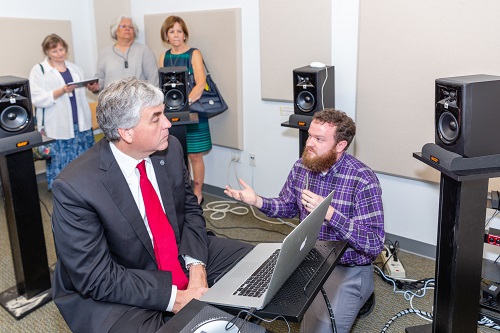Creating a More
Welcoming World for Deaf, Hard of Hearing, and Deaf-Blind Individuals
HHS Deputy Secretary Eric
Hargan participates in technology demonstration simulating a noisy
real-world environment
at Gallaudet University
with David Thornton.
From smartphones to social media, technology is reshaping our
world. For people with disabilities, advancements in technology and
engineering have the potential to knock down long-standing barriers to
communication, employment, and full community participation. ACL’s
National Institute on Disability, Independent Living, and
Rehabilitation Research (NIDILRR) works to translate that potential into
real-life solutions that increase choices, opportunities, and
accommodations.
For more than 30 years, NIDILRR has funded a variety of
research projects at Gallaudet University — a pioneer in advancing
educational opportunities and research for the deaf and hard-of-hearing
communities. On June 25, HHS Deputy Secretary Eric Hargan and ACL
Administrator Lance Robertson got an up-close look at the impact of
Gallaudet’s NIDILRR-funded work at the university in Washington, DC.
NIDILRR-funded projects at Gallaudet include the
Rehabilitation Engineering Research Center (RERC) on Improving the
Accessibility, Usability, and Performance of Technology for Individuals who
are Deaf or Hard of Hearing. A key principle behind Gallaudet’s work is
that people who are deaf or hard of hearing should be directly involved in
developing solutions to address the barriers they experience.
“No one walks in our shoes or has our experience,” said
Christian Vogler, Ph.D., Director of Gallaudet’s Technology Access Program.
Involving the community in these projects ensures that technologies address
real-life needs and situations. Deputy Secretary Hargan, who learned
American Sign Language as a child to communicate with a friend, was eager to
experience first-hand how some of this technology works. Sitting in the
center of an elaborate speaker system, he experienced what it was like for
people who are hard of hearing to follow a conversation while driving.
Individuals experiencing hearing loss will often test a hearing aid in a
clinic, but then grow frustrated when the device does not work as well in
the real world. The RERC’s simulation technology helps audiologists adjust
hearing aid settings to optimize communication in realistic situations and
increase use and usability of hearing aids.
In the lab next door, ACL Administrator Lance Robertson
watched as David Bush, a consumer participant in the research project,
demonstrated how a RERC-developed tele-rehabilitation program taught him to
use his cochlear implant more effectively. Bush lost his hearing as an
adult due to a degenerative condition that runs in his family. He first
used hearing aids, but in 2016 received a cochlear implant, which has made
a “dramatic difference” in his ability to communicate with others.
 Graduate student Kate Witham
demonstrates a tele-rehabilitation program for ACL Administrator Lance
Robertson and HHS Deputy Secretary Eric Hargan. Graduate student Kate Witham
demonstrates a tele-rehabilitation program for ACL Administrator Lance
Robertson and HHS Deputy Secretary Eric Hargan.
Also on hand was Judy Alden, who is part of a
train-the-trainer program the RERC is piloting with the Hearing Loss
Association of America. The program recruits trainers who are deaf or hard
of hearing to train others experiencing hearing loss in using hearing
technology. It aims to increase knowledge, skills, and understanding
of hearing loss. Alden, who started losing hearing in her 30s and who has
used hearing aids for more than 20 years, wants to help prevent the
isolation that may come with hearing loss. She has reached more than 175
health professionals, older adults, and family members through formal
sessions and many more through informal networking.
Linda Kozma-Spytek captured the idea behind the project with a
simple question, “who better to learn from if you're a new hearing aid
learner than people who have gone through this experience before?”
Reflecting on the impact of the RERC’s work, Gallaudet
University President Roberta (Bobbi) Cordano, J.D. said, “we know that the
work that we're doing here is supporting the personal and professional
success of deaf and hard of hearing individuals throughout their lifespan.”
“We're creating a world that is more welcoming and more
supportive for deaf, hard of hearing, and deaf-blind individuals,”
President Cordano added.
|



No comments:
Post a Comment